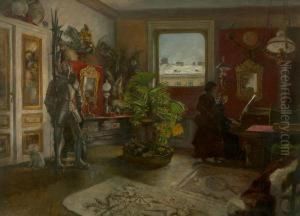Joseph Von Kopf Paintings
Joseph von Kopf was a German sculptor who played a notable role in the art scene of the 19th century. Born on July 25, 1827, in Oberndorf am Neckar, Württemberg, he began his artistic journey at a young age. Initially, he trained at the Stuttgart Art School, where he honed his skills and developed a passion for sculpture. His talent was evident early on, and he soon sought to further his education and experience abroad.
In 1852, von Kopf moved to Rome, which was a major center for artists at the time. The vibrant artistic atmosphere of the city and the abundance of classical sculptures provided him with ample inspiration and opportunities to refine his craft. In Rome, he was profoundly influenced by the Italian Renaissance and ancient Roman art, which is reflected in his later works.
Throughout his career, Joseph von Kopf produced a variety of sculptures, ranging from busts and portrait statues to larger monumental works. His style combined elements of classicism with a sense of realism, capturing the essence of his subjects with both accuracy and artistic flair. He became known for his ability to convey emotion and character in marble and bronze.
Von Kopf returned to Germany and continued to work and receive commissions. His contributions to German sculpture were significant during his lifetime, and he became a respected figure among his contemporaries. Some of his notable works include statues and monuments that can still be seen in various public spaces across Germany.
Joseph von Kopf passed away on November 13, 1903, in Stuttgart. His legacy is preserved in the quality and craftsmanship of his sculptures, which continue to be admired for their beauty and expressive power. Although he may not be as widely recognized as some of his peers, von Kopf's work remains an important part of the narrative of 19th-century European sculpture.
